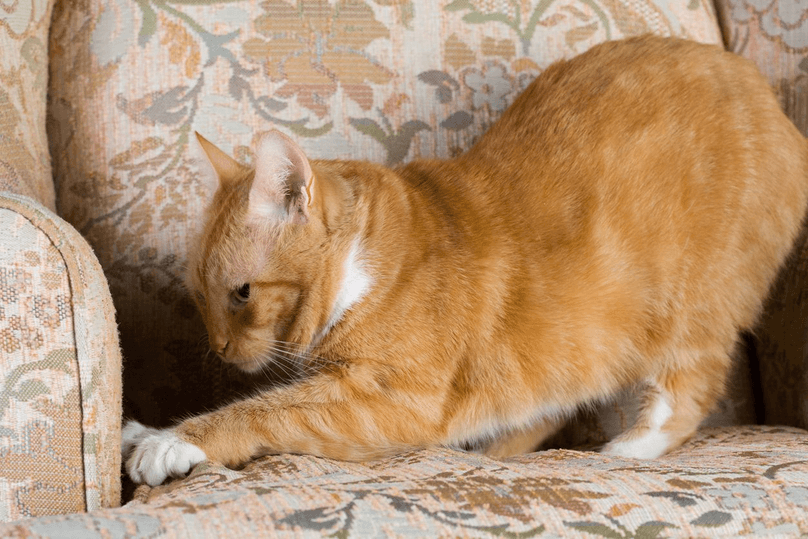
If you have cats, you know how they love to get their claws into an old rug or worse, your best upholstery. For cats, scratching is a normal—and necessary—part of life. But you do have some control over where your felines choose to do their scratching.
Here we’ll look at why cats scratch and then examine seven ways you can redirect your cat’s unwanted scratching behavior.
Why do cats scratch?
For felines, scratching serves several purposes. Scratching helps remove old claw sheaths (you may have found a few embedded in their favorite scratching fabric). It also places scent markers to communicate to other cats and assert territorial claims. Scratching also helps cats relieve stress and express their feelings—and who hasn’t enjoyed a good stretch to give tired muscles a reset?
What all this means, is that cats are going to scratch because it’s in their nature. So what can you do to prevent your pets from destroying your furniture, rugs, and upholstery? Fortunately, there are some practical solutions you can put into action today.
7 Ways to Redirect Your Cat’s Scratching
Fortunately, there are many practical alternatives that safely allow your cats to scratch—but discourage them from doing so in inappropriate places.
- Invest in a scratching post or cat tower. Scratching posts and cat towers offer your felines attractive places to stretch, scratch, and generally work out their sillies. A sturdy cat tower can provide hours of enjoyment and even a place to escape for a quick cat nap.
- Explore scratch pads in inventive shapes and textures. Give your pet some variety! Today’s scratch pads offer a wide range of designs, shapes, and surfaces to please every cat. Be sure the scratch pad you buy is sized appropriately to give your cat a satisfying stretch.
- Plastic upholstery covers offer a deterrent and a barrier to protect your best furnishings. Corner buffers and plastic no-scratch sheets are available online.
- Use textures. Just as cats love certain textures and materials, there are others they dislike with equal enthusiasm. Covering “please don’t scratch” surfaces with aluminum foil or plastic wrap can send your cat looking for an alternative scratching spot.
- Use attractants. One way to make that new scratching post more attractive? Add a little catnip. Catnip and other natural attractants can help draw your cat to appropriate scratching places. Also, by varying the available textures (cloth, cardboard , wood) of appropriate scratching surfaces will help keep your feline engaged.
- Use deterrents. Just as cats love certain scents, they strongly dislike others. A light citrus spray , for example, can help keep cats away from “no scratching” spots.
- Nail control. One way to reduce your cat’s scratching behavior is to maintain a nail-trimming schedule. Gently trimming your pet’s front claws reduces the urge to shed dead nail tissue and minimizes the risk for unwanted injuries.
Another increasingly popular way to dissuade unwanted scratching is to place plastic nail caps on your cat’s claws. Feline nail cover kits are available online, or ask your vet to help place the nail covers.
Behavioral Training for Cats
While most cats react positively to gentle incentives, some may need extra help. Behavioral therapies for cats can help to correct problem behaviors that don’t respond to other methods. Ask your vet to connect you with a Certified Applied Animal Behaviorist (CAAB) or a board-certified veterinary behaviorist (Dip ACVB). They can provide you and your pet with workable solutions to discourage unwanted behaviors.
A Note on Declawing
Though once common, declawing is now widely understood as cruel and inhumane, and the majority of US veterinary schools no longer teach the procedure. Declawing removes not just the claw, but amputates the last digit of the toe. Declawing is painful and may result in lifelong health and behavioral issues. Additionally, some states and locales have banned feline declawing.
Conclusion
As cat lovers, we understand how important your pet’s health and happiness are to you. We hope these tips help you redirect your cat’s unwanted scratching behavior. Have questions? Contact your veterinarian—they can review your needs and help you select the best scratch-deterrent for you and your pets.